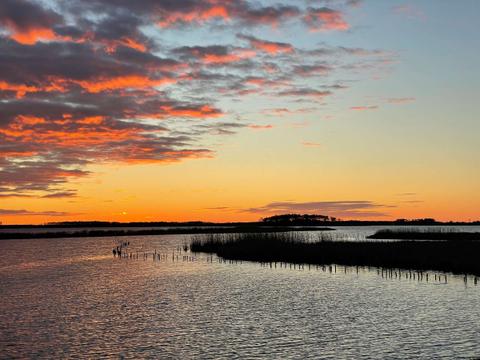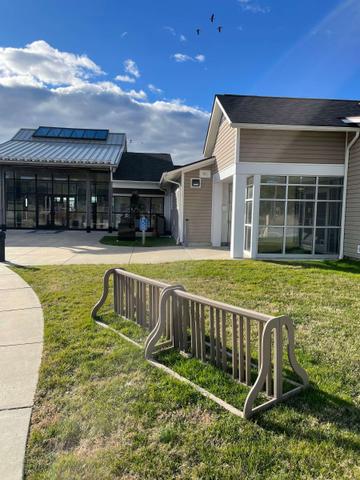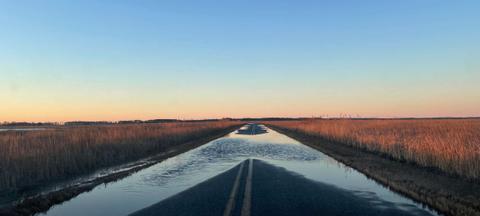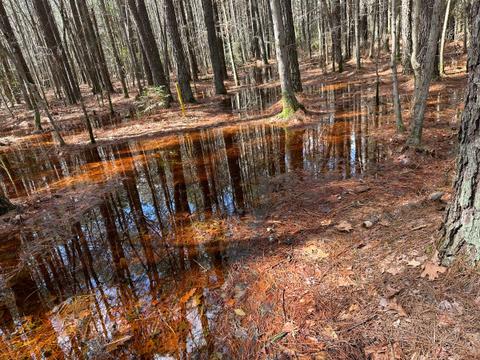
Blackwater National Wildlife Refuge
Blackwater National Wildlife Refuge
2145 Key Wallace Drive Cambridge, MD 21613-9536
Official WebsiteMaryland Ornithological Society: A Birder's Guide to Maryland and DC (Blackwater National Wildlife Refuge)
Aggregated Ebird List of Species at Blackwater
Tips for Birding
Bring spotting scope. ◾ The Wildlife Drive is great for those who are mobility-impaired, as it provides birding from or near the car, and many of the visitor areas are wheelchair-accessible. ◾ If you plan to hike the trails, waterproof boots are recommended. ◾ Blackwater NWR offers annual permitted hunting opportunities for deer, turkey, and waterfowl on selected areas of the refuge. Be aware of hunting seasons and plan your visit accordingly. Learn more about hunting at Blackwater. ◾ Restrooms are available at the Visitor Center.
Birds of Interest
January
Geese, swans and ducks are present in the marsh along with hawks, great blue herons, and a few species of shorebirds. Mid-winter observations are best during thaws. Eagles, both bald and golden, are sometimes conspicuous along the Wildlife Drive. Resident bald eagles and great horned owls lay and incubate eggs.
February
First northward bound migrants appear late in February - killdeer, robins, and bluebirds. New eaglets hatch. Wintering waterfowl are preparing for the long flight north through intense foraging.
March
Most migratory waterfowl depart for points north. Masses of red-winged blackbirds pass through; some remain to nest. Osprey return from southern wintering grounds and begin constructing nests.
April
Resident ducks and geese are incubating eggs. The majority of migrant marsh birds return by mid-April. Blue-winged and green-winged teal passing through. (Blue-winged are latest in spring and earliest in fall). Delmarva fox squirrels are born. Young bald eaglets begin hatching (although some eagles have been known to nest early, and hatch their eaglets by the end of February). Osprey, wild turkey, and northern bobwhite all begin to nest. Late April and early May heralds peak shorebird migrations.
May
Migratory songbirds peak in late April and early May with warblers being most conspicuous and abundant. White-tail fawns (usually twins) begin to appear. Eaglets start to fledge; this will occur from the end of the month through the middle of June. The first broods of waterfowl appear.
June
Ospreys hatching in June. Eaglets learn how to fly and forage. Songbirds begin to nest.
July
Local goslings start to fly. Large quantities of insects are being consumed by swallows, kingbirds, and flycatchers. The conspicuous marsh hibiscus (mallow) begins to bloom along marsh edges at the end of month. Osprey young leave the nest.
August
Wading bird numbers increase. Blue-winged teal from the north arrive on southward migration. Some bald eagles disperse northward after the breeding season. Note: In the summer be prepared for large concentrations of flies and mosquitoes in the marshes and woods.
September
Ospreys migrate to South and Central America. Waterfowl numbers gradually increase. Egrets and herons accumulate until cold weather pushes them south. Tickseed sunflowers bloom; cattails go to seed. Songbird migration peaks in late September and early October. Toads are abundant.
October - December
Autumn colors peak. Blackbirds, the last of the songbird migrants, peak in October and November. Abundance of ducks and geese gradually increases, depending upon temperatures further north. Some remain all winter, others move south or disperse throughout the Delmarva Peninsula. Prescribed burning of the marsh begins for regeneration of specific waterfowl food resources. Tundra swans from Northwest Canada usually arrive in early November. Several hundred remain throughout the winter. White-tailed and sika deer breed from October to December. Bald eagle numbers increase with the arrival of migrants from the north. Resident bald eagles begin working on their nests high in loblolly pine trees. Golden eagles are occasionally seen during winter.
About this Location
Hours:
- Wildlife Drive: dawn to dusk daily.
- Visitor Center: 10 am – 4 pm, Tuesday through Sunday.
- Visitor Center closed Mondays and all federal holidays, including Thanksgiving and Christmas Day.
- Visitor facilities may be closed during and after severe weather. To check on the status, call 410-228-2677, ext. 7620 or check Blackwater’s Facebook page.
- The Wildlife Drive, Tubman Road Trail, and other foot-trails are usually scheduled for closure for deer management on selected days during the fall and winter. These dates are posted in advance on the Refuge Status webpage.
Cost:
- $3 per vehicle.
- $1 per bicyclist or pedestrian.
- May use Duck Stamp, annual pass, or Lifetime Federal Pass. Passes may be purchased at the Visitor Center – cash or check only.
With over 20,000 acres open for public recreation, you can experience the refuge year round in a variety of ways! Over 5 miles of hiking trails and 17 miles of paddling trails provide many opportunities to view wildlife in their native habitats. If you prefer to travel by car, we have a 3.6 mile Wildlife Drive popular with photographers and birders alike, which is also suitable for hiking and cycling. And speaking of cycling, the many miles of flat, low-traffic roads in southern Dorchester County are perfect for picturesque rides for cyclists of all abilities. In addition, nearly 15,000 acres are open for deer hunting from September through January, with opportunities for waterfowl and spring turkey hunting as well.
Located 12 miles south of Cambridge, Maryland, the Refuge was established in 1933 as a refuge for migratory birds. The refuge includes more than 28,000 acres of rich tidal marsh, mixed hardwood and loblolly pine forests, managed freshwater wetlands, and croplands. It serves as an important resting and feeding area for migrating and wintering waterfowl, and is one of the chief wintering areas for Canada Geese using the Atlantic Flyway. The Refuge is probably most famous for its huge flocks of wintering Snow Geese. The refuge supports one of the highest concentrations of nesting Bald Eagles on the Atlantic coast. In recent years, a flock of American White Pelicans have taken up year-round residence, although their numbers dwindle in the warm months; this is the only place in Maryland to regularly host American White Pelican. Blackwater NWR is also a haven for one of our nation’s endangered mammal species, the Delmarva Fox Squirrel.
The Wildlife Drive is a 3.5-mile paved driving tour that provides a sample of Blackwater’s prime habitats. The Wildlife Drive has numerous opportunities to pull over to look for birds. Wetlands on the south side of Wildlife Drive are tidal. They are at their birdiest when waters are low and there is exposed mud. In mid-winter, the areas farther out on the open Blackwater River are one of the best places on the Delmarva Peninsula to see large numbers of Common Mergansers. Wetlands on the north side of Wildlife Drive have fresh water that comes from runoff in adjacent forests. Be sure to stop where MD Route 335 crosses the Blackwater River just south of Key Wallace Drive, where big numbers of Bald Eagles are frequent and 4-5 nests are usually visible.
Wheelchair Access:
The Visitor Center is wheelchair accessible. There is one paved fully accessible one-third-mile trail (the Marsh Edge Trail).Since most of the Refuge can be birded from or near the car on the Wildlife Drive, this is a great place for those who are mobility-impaired.
Pet Policy:
Pets are not allowed on the refuge outside of your vehicle, even on a leash. However, pets may be walked on a leash in the area immediately surrounding the Visitor Center. Pets may ride in your vehicle on Wildlife Drive.
Notable Trails
There are four short land trails at Blackwater that loop off the Wildlife Drive: the Marsh Edge Trail, Woods Trail, Key Wallace Trail, and Harriet Tubman Road Hiking Trail. You can download a descriptive brochure for each of these trails, except the Woods Trail, at https://www.fws.gov/refuge/Blackwater/visit/landtrails.html. Although the Wildlife Drive is excellent, we highly recommend walking some or all of the foot-trails to best experience Blackwater. In particular, the foot-trails provide the best opportunities for songbirds. In addition, there are three water trails for paddlers, and a mapped bicycling route through Blackwater and the surrounding countryside.
Features
Restrooms on site
Content from Official Website and Maryland Ornithological Society: A Birder's Guide to Maryland and DC (Blackwater National Wildlife Refuge)
Last updated November 30, 2023




